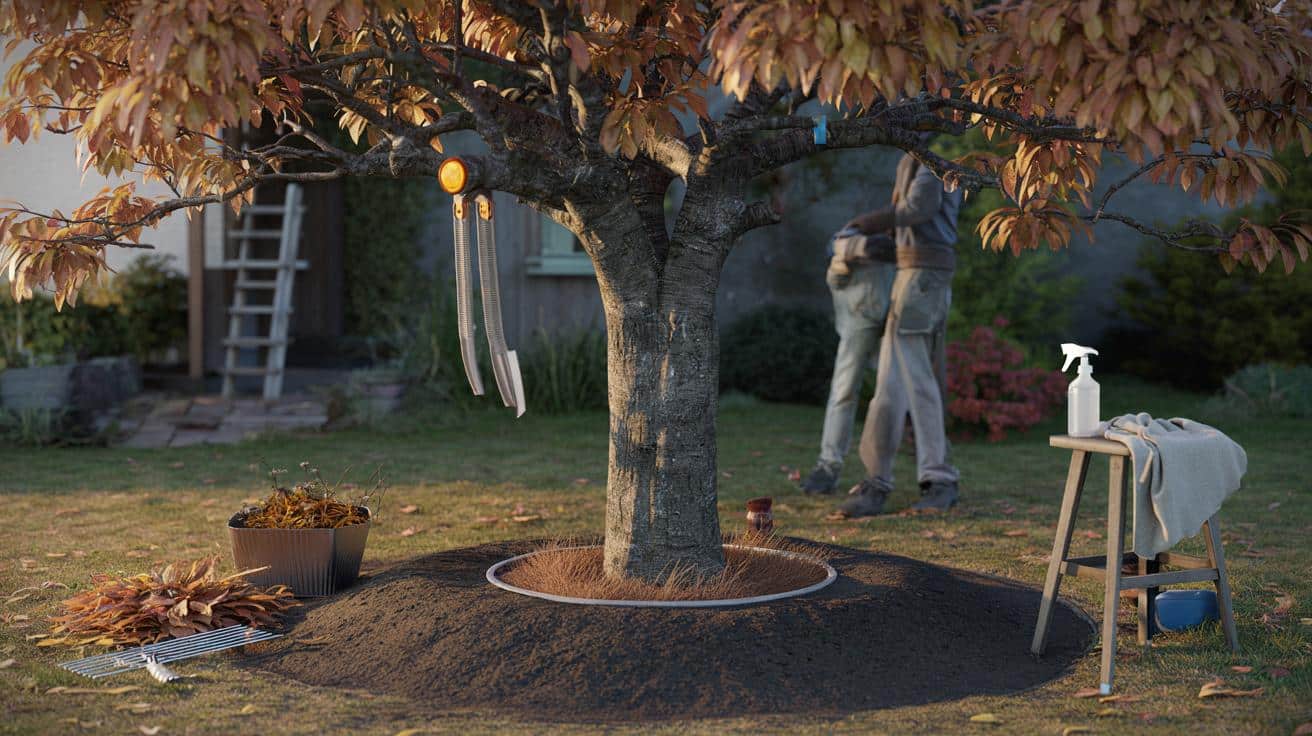Autumn whispers that it’s time to tidy, to cut, to sort the garden before the clocks change. With cherries, that tidy instinct can backfire in a way that haunts next spring. Before you touch that branch, there’s one move that separates thriving trees from silent stumps. **Prune in high summer, not autumn.**
The street was quiet except for the crackle of leaves underfoot. A neighbour leaned a ladder against his cherry, the kind that throws confetti-petals over the pavement each April, and paused like a diver on a high board. He clipped, then clipped again, and the cut wood smelt sweet in the cold air. Three months later, gum bled down the bark, silvered leaves curled like smoke, and whole spurs failed to wake in spring. I remember the silence of it. A tree that had nothing to say. Wait.
The autumn itch vs a cherry’s reality
Cherries hate autumn cutting. They’re stone fruits, which means wounds made as temperatures drop invite pathogens like silver leaf and bacterial canker when the tree can’t defend itself. Sap flow slows, healing is sluggish, and every tidy cut becomes an open door. It looks neat on the day. It can look ruinous by June.
We’ve all had that moment when the garden looks messy and your hands twitch for the tools. Last year, a Kent grower told me he “just freshened the shape” in October after fruiting was poor. By May, he’d lost a third of the canopy on one side, the branches pitted with canker and amber gum. It wasn’t neglect. It was bad timing wrapped in good intentions.
Here’s the anatomy of what goes wrong. Silver leaf (Chondrostereum purpureum) releases spores on damp, cool air, landing on cuts that can’t compartmentalise fast. Bacterial canker rides rain splash and enters the same way. In midsummer, when cherries finish fruiting and the weather’s warm and dry, the tree seals wounds quickly and pathogens struggle. In late autumn, your cut lingers raw, the humidity rises, and trouble slips in unseen.
So what should you do instead this autumn?
The tip that saves cherry trees: keep your blades off living wood until high summer. Use autumn for hygiene, not shaping. Clear fallen fruit and leaves to reduce brown rot and leaf spot, bin them rather than composting. Lay a wide mulch “doughnut” of composted bark or leaf mould around the drip line, but keep a hand’s width bare around the trunk to avoid rot. Check stakes and ties so winter winds don’t chafe the bark. It looks tiny, but this is the moment that saves a tree.
If there’s storm damage and a branch is torn, make one clean reduction cut back to a healthy lateral on a dry day. Sterilise your secateurs with methylated spirits before and after. Cut just outside the branch collar at a slight angle so water sheds, then stop. Don’t thin, don’t shape, don’t chase symmetry. Let the tree rest. Let’s be honest: nobody really does that every day.
Common traps are small but costly. Don’t smear every wound with sealant paint; modern practice for cherries is light-touch, reserving sealant for big rips if wood is exposed. Don’t volcano the mulch up the trunk. Don’t feed nitrogen now; keep fertiliser for spring growth. If you see amber gum weeping, treat it as a message, not a mess: canker or stress is speaking. **Hands off the secateurs this month.**
“Cut cherries in warm, dry weather after fruiting,” says a veteran orchardist I rang in East Sussex. “Autumn cuts invite diseases you can’t see until it’s too late.”
- Rake leaves and remove mummified fruit to cut disease carry-over.
- Mulch in a wide ring, not against the trunk.
- Check stakes, ties and guards before winter gales.
- Disinfect tools now and store them dry.
- If damage forces a cut, keep it minimal and clean, then walk away.
What happens when you wait
Restraint now buys you a busy July. When the cherries are picked and the air is dry, you can step in. Remove dead, diseased or crossing wood first, then shorten new extension growth by a third to encourage strong fruiting spurs. Work on a day with a breeze and no rain forecast. Take out no more than a fifth of the canopy in one go. Your tree will close wounds like zips.
Spring will show the payoff. Buds push clean, leaves open without a smoky sheen, and blossom turns the whole crown into a white sky. Bees hum where gum didn’t. You’ll see light and air moving through a shape you didn’t force, just guided. There’s a quiet power in not doing the dramatic thing when the season tempts you to make a change.
If you’ve inherited a cherry that’s overgrown, don’t panic-prune when the clocks go back. Map what you’ll remove next July: a big crossing limb, water shoots, congested centres. Tag branches with ribbon so you don’t forget. Take photos to plan angles. You’re training yourself as much as your tree. A small plan in autumn beats a big mistake on a cold Saturday.
Keep the ground sweet and the canopy clean
Autumn is your backstage season. Focus on the soil and the air around the tree. Spread 5–7 cm of organic mulch in a broad ring beneath the canopy, leaving the trunk clear, to buffer winter wet and feed the microbiome. Lift any grass right at the base so the crown stays dry. If the site puddles, add a shallow swale downslope to move water on. That unseen work pays the rent next year.
Scan the bark with slow eyes. Canker often starts as sunken patches that glisten, or as gumming where the tree tries to seal a wound. Cut out nothing now unless a limb is dangerous; just make a note, and keep the area tidy and dry. If birds strip fruit buds in winter, consider a loose mesh only when blossom sets, not a tight net that traps wildlife. Your tree needs air as much as defence.
There’s a tricky balance between care and fuss. A light wash of horticultural soap on a mild day can dislodge aphid eggs, then you’re done. Too much fiddling is stress disguised. If you crave action, sharpen your blades, oil the pivots, and label your pruning saw with July dates. A calm gardener in November makes a calm tree in March.
An open ending, like good blossom
It’s odd how restraint feels like a choice only after you’ve made it. The ladder stays in the shed, the secateurs click cleaned and settle in their drawer, and you walk the garden with your hands in your pockets. The cherry stands there, leaves thinning to a last flicker, a promise stored in wood you didn’t rush to shape. One clear step now, and many small joys later.
The story you’ll tell in spring won’t be about what you cut. It will be about the glow of petals and the sound under them, the way the tree filled the space without losing itself. Share the tip with that friend who’s itching to tidy this weekend. Hold them at the gate for one more minute. Let the tree do the talking.
| Point clé | Détail | Intérêt pour le lecteur |
|---|---|---|
| Skip autumn pruning | Cherries seal wounds faster in warm, dry midsummer; autumn cuts invite silver leaf and canker. | Protects next year’s blossom and crop from invisible disease. |
| Autumn is for hygiene | Clear leaves and mummified fruit; apply a wide mulch ring, keep trunk collar bare. | Reduces disease carry-over and feeds soil life with minimal effort. |
| Act only on damage | If storms tear wood, make one clean, minimal cut on a dry day and stop. | Prevents bigger infections while avoiding a spiral of over-pruning. |
FAQ :
- Can I prune a cherry tree in autumn if it’s overgrown?No. Wait until after fruiting on a dry spell in July or August. Autumn pruning risks silver leaf and canker because cuts heal slowly in cool, damp air.
- What if a branch snapped in a storm?Make a single clean reduction cut back to healthy wood on the next dry day, sterilise tools, and leave further shaping for summer. Safety first, minimal cuts only.
- Should I use wound paint on cherry cuts?Generally, no. Modern advice is to leave small, clean cuts unsealed. Reserve a breathable sealant only for large rips or exposed heartwood if the weather stays wet.
- How do I spot silver leaf early?Leaves take on a metallic sheen, and affected branches often show dieback. If you see it in summer, cut well back into healthy wood on a dry day and destroy infected material.
- What’s the best autumn job for better cherries next year?Ground hygiene and mulch. Remove fallen leaves and fruit, lay a 5–7 cm mulch ring, check stakes and ties, disinfect tools, and plan your July cuts. The quiet work now sets up the show.










Perfect timing—was about to “tidy” this weekend. Ladder back in the shed and hands in pockets. Thanks for the clear why, not just the what 🙂